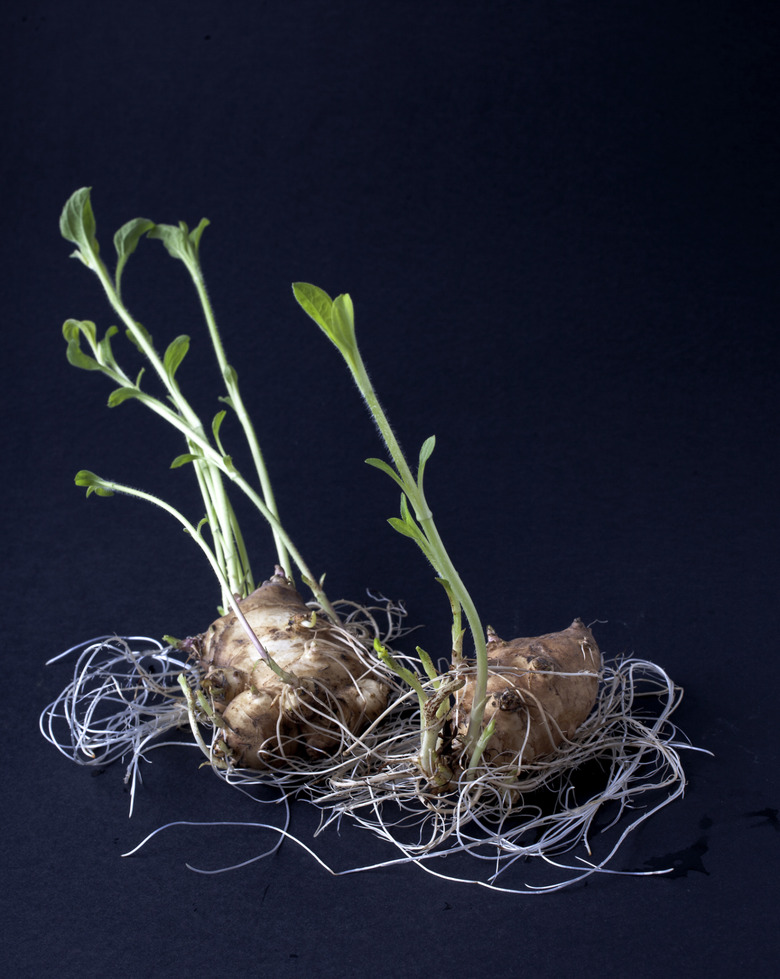Edible Wild Plants In Kansas
Once primarily prairie lands of short and tall grasses with some woodlands near rivers, Kansas is now mostly cropland and rangeland. The topography contains mostly plains and hills broken by streams and rivers. Summers are warm and winters cold with moderate snowfall.
Once primarily prairie lands of short and tall grasses with some woodlands near rivers, Kansas is now mostly cropland and rangeland. The topography contains mostly plains and hills broken by streams and rivers. Summers are warm and winters cold with moderate snowfall. Kansas receives from 45 to 20 inches average annual rainfall and contains U.S. Department of Agriculture cold hardiness zones 5b through 7a. Vegetation consists mostly of agricultural plants, but woodlands, fallow fields, ditches, vacant lots and remnant native grasslands still harbor wild edible plants.
Tubers and Roots
Protected from winter's cold by layers of soil and snow, Jerusalem artichoke (Helianthus tuberosus) is a large perennial sunflower with brown, edible tubers on the roots. Plants thrive in rich soil but tolerate a wide variety of soil types. Plants need full sun and grow quickly each year to 7 feet tall and 2 feet wide in USDA zones 4 through 8. The easy-to-grow plants need full sun and loose, well-drained soil. In some areas, Jerusalem artichoke can become invasive. The starchy roots of cattail (Typha latifolia) are best harvested from fall to spring when the starch content is highest. The plant grows in moist soils and standing water in marshes, ponds and wetlands. Hardy in USDA zones 3 through 10, other edible plant parts are the shoots, flowers, seeds and pollen. Grow cattail in full sun or part shade in a shallow pond or marshy area, but contain the roots in a large bottomless container to prevent invasive growth.
- Once primarily prairie lands of short and tall grasses with some woodlands near rivers, Kansas is now mostly cropland and rangeland.
- The starchy roots of cattail (Typha latifolia) are best harvested from fall to spring when the starch content is highest.
Edible Leaves
Growing widely throughout the state in almost any soil type, dandelion (Taraxacum officinale) yields tender, young, spring leaves for salads and cooking greens. Hardy in USDA zones 5 through 9, dandelion features a sturdy, perennial tap root. The flowers and roots are also harvested, and varieties exist for garden planting. In some areas it's considered invasive. Not as cold hardy, purslane (Portulaca oleracea) is hardy in USDA zones 9 through 11 and grows as an annual in Kansas. The oval, succulent leaves and reddish stems are used fresh in salads, cooked as a green or used as an ingredient in various dishes. The low-growing, branching plants are often weeds in lawns and disturbed areas, and can be invasive.
- Growing widely throughout the state in almost any soil type, dandelion (Taraxacum officinale) yields tender, young, spring leaves for salads and cooking greens.
- Not as cold hardy, purslane (Portulaca oleracea) is hardy in USDA zones 9 through 11 and grows as an annual in Kansas.
Berries and Fruit
Usually ready to pick in summer or fall, a number of Kansas wild plants bear edible fruit. Wild strawberry (Fragaria virginiana) inhabits prairies, pastures, fields and wood margins in the eastern one-half of Kansas. The low-growing plants propagate by runners and produce berries that grow 1/2 to 3/4 inches wide. Wild strawberry is hardy in USDA zones 4 through 7. Wild gooseberry shrubs yield round fruits about 1/2 inch in diameter. At first green, the gooseberries ripen in summer to purple. They're eaten fresh or made into pies and jams. Find the bushes in woodlands, thickets and rangelands. Grow the bushes in full sun or in an area with afternoon shade. Provide fertile, moist, well-draining soil. Water the plant regularly during periods without rain.
- Usually ready to pick in summer or fall, a number of Kansas wild plants bear edible fruit.
- Wild strawberry (Fragaria virginiana) inhabits prairies, pastures, fields and wood margins in the eastern one-half of Kansas.
Nut-Bearing Trees
Two large, deciduous trees that bear edible nuts occur in Kansas. Pecan (Carya illinoinensis), hardy in USDA zones 5 through 9, occurs in eastern Kansas. Growing 75 to 100 feet tall and 40 to 70 feet wide, trees prefer river bottoms. Pollinated female flowers mature into oblong nuts with sweet-tasting kernels. Also preferring deep-soiled bottomlands, black walnut (Juglans nigra) grows in central Kansas and is hardy in USDA zones 4 through 9. Also reaching 75 to 100 feet tall, the tree has a equal spread. The nuts are within a fleshy green husk that turns black as it rots away. The kernels are tasty but hard to remove from the shell. Black walnut produces toxins in the area directly beneath the tree which can affect growth of other plants nearby, and husks can stain pavement and sidewalks. Both trees need lots of space in deep, fertile, well-drained, moist soil.
- Two large, deciduous trees that bear edible nuts occur in Kansas.
- Black walnut produces toxins in the area directly beneath the tree which can affect growth of other plants nearby, and husks can stain pavement and sidewalks.
References
- U.S. Department of Agriculture: Agricultural Research Service: USDA Plant Hardiness Zone Map
- Plants for a Future: Helianthus Tuberosus – L.
- Plants for a Future: Typha Latifolia – L.
- Plants for a Future: Taraxacum Officinale – Webb.
- Floridata: Portulaca Oleracea
- Kansas Wildflowers: Kansas Wildflowers & Grasses: Wild Strawberry
- Plants for a Future: Fragaria Viginiana – Duchesne.
- Missouri Botanical Garden: Ribes Missouriense
